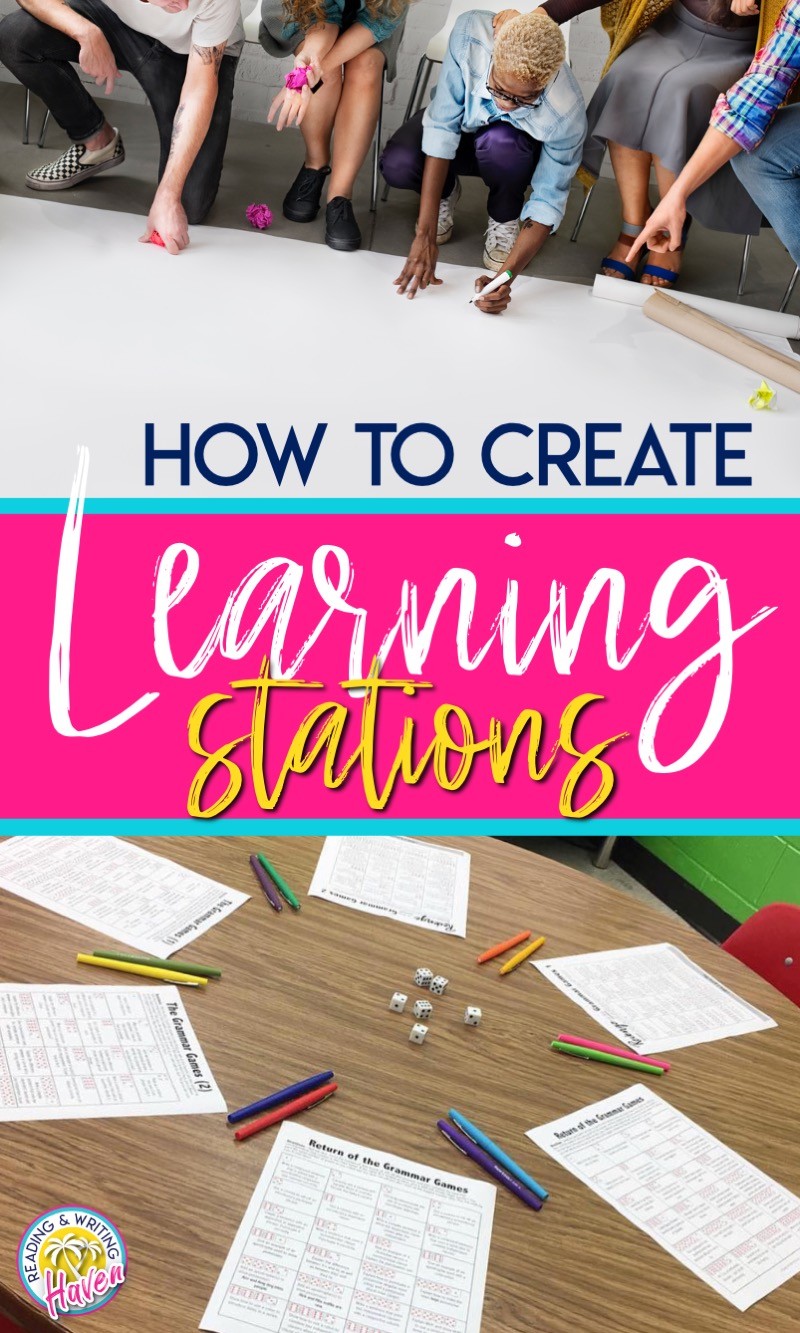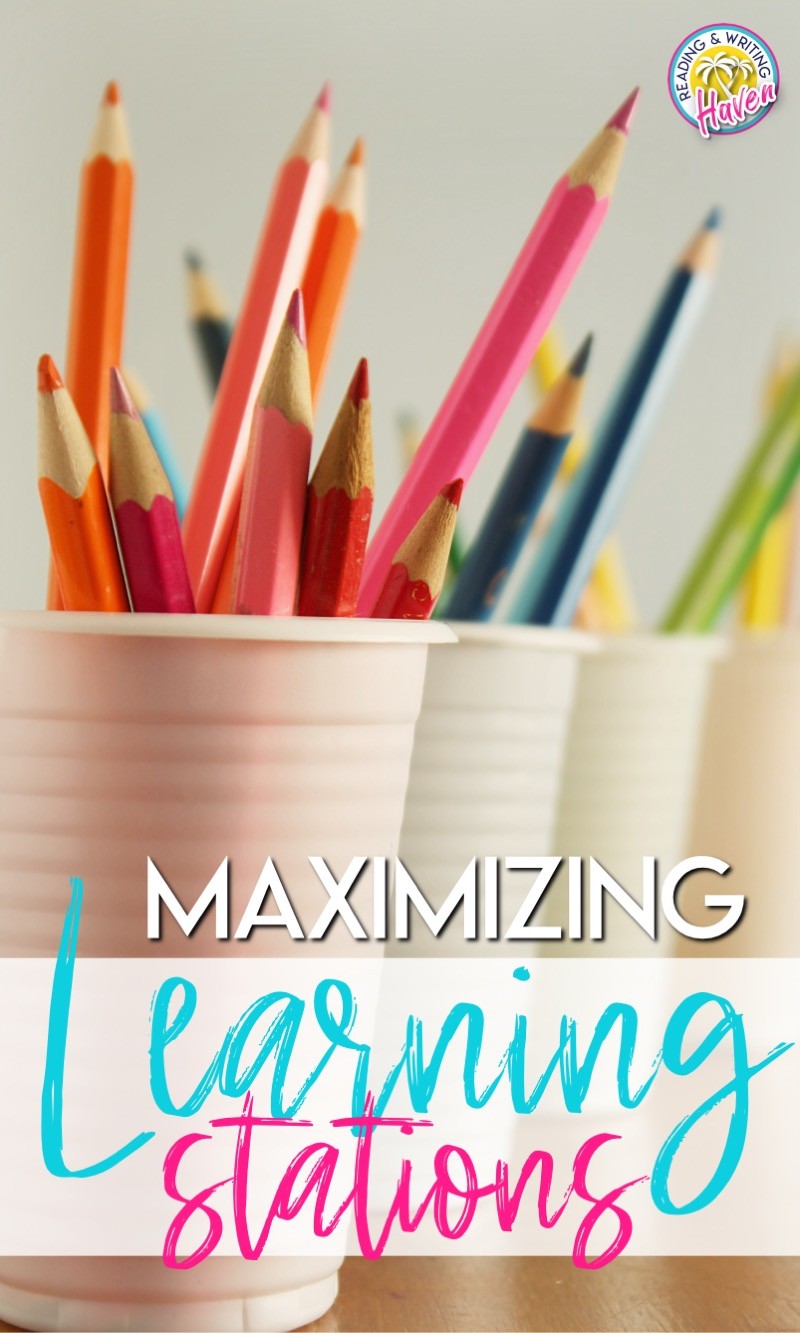How to Create Learning Stations Students will Love
What if you could blend differentiation, brain-based learning, collaboration, and student engagement all into one power-packed lesson? It’s possible! In this post, you’ll find ideas for how to create learning stations that maximize movement, differentiation, and student engagement.
If learning stations are new to you, just picture students spread out around the room working in small groups (usually selected by you based upon skill needs or readiness levels). Each group is working on a different task that targets an area students need to practice. Identify your standard, deconstruct it (what must students be able to do and understand to be proficient with that standard?), and create tasks to help students develop those skills. Each station may last for 10-15 minutes (or however long you think is necessary). Students rotate between stations (yay – movement!) and participate in a variety of practice opportunities.
Before we get into some of the details about using learning stations effectively with older students, it’s important to note that learning stations require strategy. We can’t just gather some random activities and put them in corners of the room, hoping students will stay on task and take something away from the experience. I’ve made that mistake, and it feels very much like busy work for students.
Learning stations have to be purposefully designed. Is off-task behavior a concern? We have to work at building a culture in which students stay focused and respectful. Most importantly, while students are doing the thinking in learning stations, it’s the teacher’s job to make sure they are getting targeted practice and to identify common misconceptions, areas of strength, and points for growth.
So, let’s look at some possibilities for designing and executing the practice in middle and high school.
DESIGNING LEARNING STATIONS
When we create learning stations, we need to first identify the learning goal. Are you trying to pique students’ curiosity about a culture or time period? Are you trying to build background knowledge? Or, are you emphasizing the inherent behaviors and understandings of a specific standard? Often, learning stations are a way to differentiate skills students have already been introduced to during direct instruction.
Not all stations in the lineup need to be about the same topic. If you want students to engage in critical thinking about grammar, vocabulary, analysis, and writing about something they are reading, you could create each station to address one of those topics.
Let’s say you are reading a short story. Stations might include:
- small group reading strategy instruction with the teacher
- mentor sentence analysis from the story
- connotation and denotation exploration in word choice
- responding to an essential question or a standards-aligned prompt (ex – how does the setting impact the storyline) in writing
In this way, you’ve essentially created a differentiated close reading experience for students. They are required to look back at the text four times, but each time through a different lens and with a fresh purpose for reading.
DIFFERENTIATING STATION TASKS
When you sit down to create learning stations, make sure to build in some differentiation. How might that look in middle or high school?
Use low-floor, high-ceiling tasks.
Select tasks that are open ended. In other words, make sure students of all readiness levels can access the activity. For instance, if you ask students to identify character development, give them a graphic organizer. Some of them are going to be identifying obvious details from the story, while others will naturally lean toward making higher-level inferences. All students can be involved at their readiness level.
Give students ownership.
One of the most effective ways to ensure students are engaged in learning stations is to give them voice and choice.
Voice: Tell them about the learning target, and ask them, based upon what they already know, how they would like to practice and develop those skills more. They might not have a specific answer on the spot, but they might be able to suggest something like, “a game” or using a tech tool.
Choice: Provide a few different learning options at at least one of the stations. Vocabulary? Have them create sketch associations, create (or complete) analogies, or use pictures as inspiration to write sentences using the words. This resource contains many more ideas for creative vocabulary learning station activities.
Build in tiered activities.
When you create learning stations, you should have an idea of your students’ current aptitude with the content and skills. Build in some tiered activities so that no one is bored or under-challenged. Let’s use writing as an example. Perhaps you give students three options at a station.
- Revise your essay for fragments and run-ons.
- Incorporate a few dependent clauses as transitions.
- Find at least one hole or flaw in your arguments, and brainstorm how to fill or revise it.
To prevent students from flying down the list without digging in to each task, you could tell students which one you want them to focus on that day. If they finish early and their group members don’t have any revision suggestions, they can move on to the next item.
Vary learning preferences.
Brain research supports many of the approaches already mentioned in this post. While the validity of learning styles is still highly debatable, I have noticed a difference in learning when students are offered opportunities to explore new information through multiple avenues. To increase engagement, try building in different learning preferences.
For example, when studying how to embed cited research…
- Students might use manipulatives on their desks or tables. Where does the signal phrase go? the quote? the punctuation? Where should the punctuation go?
- Add a video or two short ones students can watch and then give them choice in how they want to take notes – a t-chart, sketch notes, etcetera.
- Use highlighters to have students color code the various aspects of the embedded quote. Color code them!
- On big chart paper, ask students to work together (standing, if you prefer, for movement) to write the quote’s introduction, the quote, and the elaboration. Have them annotate their work.
INCORPORATING MOVEMENT
Students will naturally move when they rotate between stations, but when you create learning stations, you can also build in movement intentionally. For instance, before rotating, maybe walk students through some simple neck or forearm stretches to reduce stress. Play a song and dance to the next station. When you stop the music, students know that is their cue to get started.
Build movement into your actual station activities by having them do a mini scavenger hunt. Hang task cards in the hallway. Incorporate games or skits that add small movement. Use Post-It notes to have them arrange or classify ideas. Or, ask them to write ideas on the board.
CREATING AN EFFECTIVE GROUP WORK CULTURE
Even if you have designed the best learning stations on the planet, you might end up walking away frustrated if the classroom culture doesn’t suit them. So, when you create learning stations, consider the “what ifs.” Here are some instructional strategies I’ve found beneficial in creating an ideal culture that supports learning stations.
Involve students in creating the norms.
Explain to students what learning stations are. Maybe even show them a video clip from the web so they can see them in action. Then, brainstorm together what effective learning stations should look like, sound like, and feel like. Compile their ideas on chart paper, and each time you use learning stations, review the chart first. Reminders never hurt!
Build group work stamina.
Keep track of how long students are able to work together and stay focused. Then, create a visual (a common one is a bar chart on big paper) showing how many minutes students increase each time. If there is a disruption, stop the class, review the norms, and then get back to work.
Focus on evidence of learning.
Accountability is somewhat of a taboo term any more, but we do need evidence of learning. Combine the information you hear and see when observing your students with an exit slip or learning station notes page. Use this evidence to reflect on the effectiveness of the instruction and to plan future teaching.
Consider including a teacher station.
Learning stations are an opportunity for you to sit with small groups of students to give them targeted instruction! Maybe the whole class is working on being able to analyze theme, but different groups of students are at different readiness levels. Form your groups so that when you meet with each of them, you can tweak the theme lesson to fit their needs.
Some students might be identifying themes that don’t extend beyond the text. Others might need to work on supporting the theme with text evidence. Or, maybe they are ready to dig into a mini lesson about how to explain theme using plot, character development, and conflict.
I would suggest not incorporating the teacher station until students have demonstrated the ability to stay focused during the learning stations.
Use a visible timer.
Whether you display the station rotation times on the white board or use one from online, make sure students can see how much time they have to finish their work. The sense of urgency will be there, which will keep them on task. I find timers help me to keep order as well! If I’m working with a group, time can get away from me, and then the subsequent stations are shortened.
Plan for fast finishers.
Don’t compile a bunch of worksheets. But. Do have an idea of what you want students to do if they finish early at a station. Should they watch a related video to add to their understanding on the topic? Reading a book of their choice or responding to reading with writing are also meaningful options. Students could improve their listening comprehension by tuning into a podcast. Or, have students work on reviewing their vocabulary words.
Have a back-up plan.
Some students don’t do well with lots of transitions and unpredictability. Have a back-up plan ready for them. Maybe that includes working through a Hyperdoc of very similar learning experiences but in a quiet location or next to a teacher. This shouldn’t be a punishment. Have a private, one-on-one conversation with any students necessary during or after your first round of learning stations. Ask them if they’d prefer to learn in a different format, and tell them you have an option they might like better!
Learning stations often take some prep time, but once you have stations established that you love, you can use them again. If you can’t incorporate all of these tips for success, that’s okay, too! This is what works for me, but they are also insights I’ve gained over fifteen years of teaching. I knew very little of this as a first-year middle and high school teacher. If you do your best to incorporate stations and part of the experience flops, celebrate it as a learning experience and try again.
If you’d like to dig into a different perspective for how to create learning stations, Language Arts Classroom provides her approach, specific to making grammar engaging, in this post.
RELATED RESOURCES:
Get started with learning stations! Here are some resources that will save you time:

